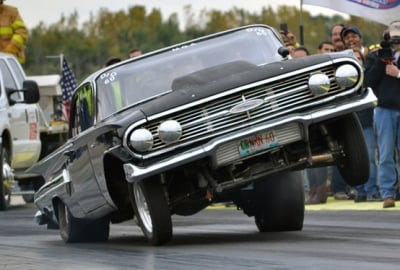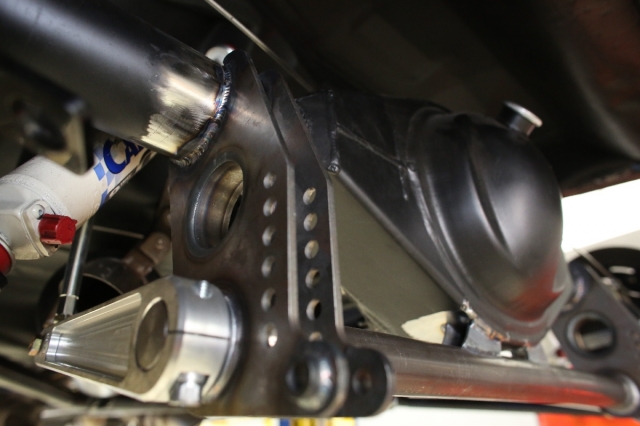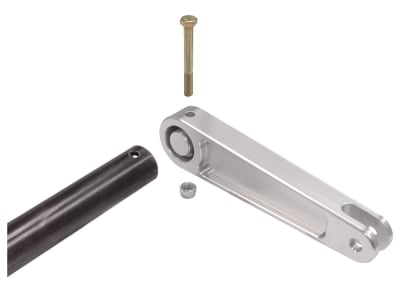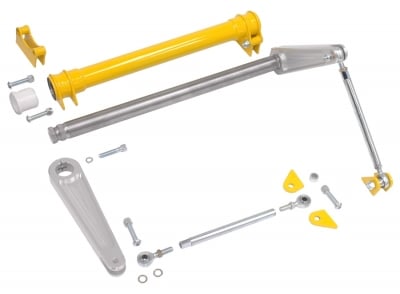Drag racers are always looking for ways to make their car faster and more consistent at the race track. As a drag racer, we tend to focus our time and money on the engine combination, yet we overlook some very basic and relatively cheap components that would accomplish these very things. One of those components happens to be an aftermarket anti-roll bar, which is virtually standard equipment in drag racing.
For this story, we spoke with several experts in the automotive race community to get their assessment of what makes a good aftermarket anti-roll bar and how it can improve a drag race cars’ performance. As you will see within this article, there are multiple anti-roll bar configurations to meet the needs of the street enthusiast all the way to the hard-core drag racer. Chris Alston Sr., the president and CEO of Chris Alston’s Chassisworks provided insight on their manufacturing operations and full line of anti-roll bar for street/strip and drag race applications.
Thor Schroeder, who is the National Sales & Marketing Manager for Competition Engineering/Moroso also provided technical insight on Competition Engineering’s product line. We also spoke with Steve Spohn, president of Spohn Performance to get a better understanding on their bolt-on anti-roll bar kit that is marketed towards street/strip and drag race applications.
If you’ve spent much time around a drag strip, you have undoubtedly witnessed a car that pulls the left front tire higher off the ground than the right front tire. What is actually happening is the car is transferring force from the right rear tire and putting it onto the left side of the car. When the force is transferred to the left side of the car, the force on the right tire is reduced, which can result in traction issues. In heads-up racing, this can mean the difference between winning and losing a race.

While it looks pretty cool in a photograph, this is a textbook example of the need for an anti-roll bar in a drag racing vehicle, as you can clearly see excessive force from left to right.
Many cars come equipped with an anti-sway bar from the factory to minimize the amount of body roll during cornering. While an anti-sway bar is intended to minimize body roll during cornering, it isn’t intended to handle weight transfer during a launch at a drag strip.
The terminology for an anti-roll bar (ARB), sway bar, and stabilizer bar are typically interchangeable since the component is intended to perform a similar task of preventing excessive lean or roll during acceleration or launch. Most of the aftermarket racing community refers to the product as an anti-roll bar, whereas an auto manufacturer might refer to the component as a stabilizer bar or sway bar. Within this article, we will refer the drag race aftermarket products offerings as anti-roll bars or simply ARBs.
OEM Sway Bar Theory
An OEM sway bar is intended to limit the body roll of the vehicle during cornering and aggressive driving, such as sudden lane changes. An OEM sway bar consists of a solid or hollow forged steel bar, rubber mounting bushing and connection links with sandwiched rubber isolators. Since this bar is designed to meet the needs of the average consumer and not the performance enthusiast, the tolerances and overall feedback of the sway bar is typically loose.
Drag Race Anti-Roll Bar Theory
There isn’t a specific horsepower range when racers should add an anti-roll bar, but if the car is experiencing body roll during launch, then an anti-roll bar will definitely help. – Thor Schroeder
With an anti-roll bar installed, the torque pushing the left rear tire down is counteracted by the ARB’s connection to the differential which results in a level launch and consistent elapsed times. Any flex in the anti-roll bar system can result in inconsistencies in the launch, which is why the construction of the anti-roll bar is very important. We will discuss the construction of the anti-roll bar and walk you through an installation later within this article.
The drag race anti-roll bar has been around since the 1970’s, but racers would have to take their car to a competent chassis shop back in the day to have a custom anti-roll bar fabricated. Alston explains the coming of age of mail order ARB’s, telling us; “While we didn’t invent the drag race anti-roll bar, we were one of the first companies to offer an anti-roll bar kit that customers could install in their garage.” Modern day racers are lucky to have companies that specialize in direct-fit anti-roll bars that can be installed with very little modifications to the car.
Chris Alston Chassisworks has invested in state of the art CNC machining systems to lower their manufacturing costs while improving quality control. A pair of thru-bolted anti-roll bar arms are being machined in the photo above
Application Considerations (Street/Strip, Race Only)
When selecting an aftermarket anti-roll bar, the user should take into consideration the intended use of the vehicle. If the vehicle is going to be used primarily for the street, with occasional trips to the track, a hardcore race anti-roll bar might not be the best option, as the ride quality of the vehicle will suffer.

The anti-roll bar setup that we’ll be walking you through later in this article, shown with the billet arms and connection links installed and everything buttoned up.
According to Spohn, “A drag race anti-roll bar typically isn’t street friendly, it’s made to keep a car straight when going straight.” While this may deter some customers away from a hardcore anti-roll bar system, it should be noted that the connection links can easily be removed for street operation and then re-installed at the track.
Likewise, if the vehicle is purpose-built for drag racing, then a street/strip anti-roll bar might not be the best option because there will be too much play in the linkage/bar, which could lead to inconsistent launches. Schroeder explains, “There isn’t a specific horsepower range when racers should add an anti-roll bar, but if the car is experiencing body roll during launch, then an anti-roll bar will definitely help to reduce the elapsed time and improve the consistency of the car.”
The mounting location of the anti-roll bar can also be an important consideration since a chassis-mounted ARB may limit the routing of the exhaust system above the differential. If the car is going to have full exhaust, then a housing-mounted ARB would be a good option since it offers the space above the differential housing. While the differential-mounted anti-roll bar offers more clearance for exhaust system routing, it does make it more difficult to jack up the rear end of the vehicle. The trade-off on the differential-mounted ARB is the installation can be harder, as it requires out-of-position welding if the differential housing is still on the car.
Modern day racers are lucky to have companies that specialize in direct-fit anti-roll bars that can be installed with very little modifications to the car. – Chris Alston Sr.
Anti-Roll Bar Construction
Aftermarket anti-roll bars are typically fabricated from 4130 chromoly steel due to its high strength-to-weight ratio, resilience to flexing/deformation and ease of welding. The shafts are supported either by plastic (Nylon) bearings, metallic sleeve bearing or ball bearings which allow the ARB shaft to rotate freely. In order to counteract the force of the suspension unloading, link arms are used to connect the rotating ARB shaft to the chassis. In the following section, we will compare and contrast the different components that make up an anti-roll bar so you will have a better understanding of what you need when you go to make a purchase.
Alston Sr. explains, “We install the chassis mount anti-roll bar bearings in a tube the spans the width of the car. This way, if the chassis twists, the bar rotates the bearing blocks the same amount, which helps to prevent binding within the system.”
Bearing Material

A nylon flange bearing is being inserted into the housing bracket for a housing mounted anti-roll bar.
Plastic bearings are typically made from Nylon plastic material and provide smooth operation of the anti-roll bar. Nylon sleeve bearings can wear out after a couple years of hard use, so the functionality of the anti-roll bar might degrade until the nylon sleeve bearings are replaced.
Metallic sleeve bearings are stronger than plastic sleeve bearings and are typically made of aluminum or brass, so they require a grease fitting. Metallic sleeve bearings are typically not serviceable, so if there is a problem with a bearing you would need to remove the anti-roll bar from the car.
Lastly, flange-style ball bearings are used on some higher end anti-roll bar kits such as the Competition Engineering Magnum Series piece. A flange ball bearing offers an extremely smooth shaft rotation due to the precision ball bearing construction, which is ideal for a drag race anti-roll bar system. According to Schroeder, “there is a trend to offer more anti-roll bars with Spherical Ball bearings instead of Nyliner (nylon flange) bearings due to the smooth operation of the ball bearing system and ease of dis-assembly and maintenance.”
Arm Design and Connection Interface
The pivoting anti-roll bar shaft is connected to a pair of link arms that are typically fabricated from billet aluminum or chromoly steel. Some manufacturers weld the chromoly arms directly to the ARB shaft which creates a very strong and rigid setup. The only downside to welding the arms directly to the shaft is that it makes servicing the anti-roll bar nearly impossible should a bearing failure occur.
Another way to connect the arms of an anti-roll bar is a thru-bolted construction. Chassisworks offers an anti-roll bar setup where billet CNC aluminum arms are connected to the ARB shaft using bolts. A key feature to this thru-bolted design is the addition of the aluminum stud that fits inside of the chromoly tube. This added feature allows the user to tighten down the anti-roll bar arms onto the hollow tube without crushing or deforming the tube.
As you might have guessed, the downside to this setup is the amount of play that can be formed in the connection point after multiple hard launches. This setup would typically be best suited to a street/strip car that occasionally sees some action at the race track.
Another method of connecting an anti-roll bar arm to the shaft is through the use of splined components, as this enables the end user to service the ARB bearing if one were to become damaged. Aluminum arms are CNC-machined with female splines so they can be slid over the male spline of the anti-roll bar. The male splines are typically CNC-machined out of solid chromoly material and then welded to the main anti-roll bar tube.
Once the control arms of the anti-roll bar are installed, they’re tightened onto the shaft with connection bolts on the end that squeeze the aluminum arms onto the shaft. While it still could be possible to generate play within this connection point, it’s not likely due to the number of splines distributing the torque at the connection point.
Link Material and Construction (Heim Joint vs. Rubber)
The link arms from an OEM sway bar are typically constructed of steel rods that are connected to the anti-roll bar and differential with sandwiched rubber isolators. This type of setup provides a smooth ride and does not transmit all of the road vibrations into the vehicle. The sandwiched rubber isolators create a lot of play within the sway bar system which makes for unpredictable performance in a race system.
Most aftermarket ARB connection links feature threaded aluminum connection rods for weight savings. A heim joint is threaded into the connection rod at each end to create an assembly that’s very strong and has minimal end play. While heim joints are very desirable in a drag race anti-roll bar system, it might not be ideal for a car that’s regularly driven on the street, as every road bump would be felt in the car.
Biting Bullet Mustang Installation

Here is the rear suspension on our Biting Bullet Mustang before the installation of the CA Chassisworks anti-roll bar.
We recently took the opportunity to update the suspension on our ’65 Mustang Project Car, Biting The Bullitt, which will see both road and track duty, with an anti-roll bar setup. With 1,000 horsepower on tap from the supercharged small block Ford, our project car was in need of some work in the suspension department to get that power to the ground. We contacted our friends at Chassisworks to hook us up with a weld-in anti-roll bar system for our early model Mustang, which we’re going to walk you though in detail.
A break down view of our housing mounted anti-roll bar (p/n: 6265) is shown on the left. The photo on the right shows the parts as they were un-boxed from CA Chassisworks. As you can see within the picture, the cross tube must be welded by the end user so that the dimensions can be verified on the car.
Because we have a fully functional shop at our disposal , we’ll also be doing things the DIY-way. Chassisworks supplied us with their top-of-the-line, housing-mounted anti-roll bar system (Part# 6265) since it wouldn’t interfere with the full exhaust system on our Mustang. This housing-mounted piece features a 1-1/4-inch diameter, 48-spline torsion bar, nylon flanged bearings, billet aluminum arms and 4130 rod ends.
The Chassisworks ARB requires the cross tube to be TIG-welded to the housing-mounting bracket. The process starts by installing the cross tube into one of the housing mounts and welding the flange to the tube. It’s important to verify that the cross tube is fully inserted into the housing mount and the pieces are square to each other, as any mis-alignment can cause binding of the anti-roll bar. The billet arm can be installed and tightened to one end of the splined torsion bar. The flange bearings can be installed on the torsion bar prior to sliding the part into the partially welded ARB mount.
The remaining housing mount can now be installed over the cross tube to verify the fitment prior to final welding. The second billet arm can be installed on the splined torsion bar. If the fitment appears to be correct, the second housing mount can be tack-welded to the cross tube. It’s important to remove the spline torsion bar and nylon flange bearings before final welding, as the heat from the welding process can deform the bearings.
The anti-roll bar was setup without the torsion bar so the width of the anti-roll bar can be verified. Grease is applied to the nylon flange bearings to ensure smooth rotation of the ARB.
The anti-roll bar is mocked up on the car to check the dimensions prior to final welding. The finished anti-roll bar is shown with the billet arms and connection links installed.
Now that the anti-roll bar is tacked together, we wanted to verify the fitment on the car. The Mustang was put on a lift so we would have easy access to the differential housing. We used a pneumatic grinder with an abrasive disc to remove the paint from the differential housing in the areas where the housing-mounting brackets would be installed. A jack was used to hold the anti-roll bar mount to the differential housing while the dimensions were verified.

The housing brackets were TIG welded to the axle tube to create very strong yet visually appealing weld.
The fitment of the ARB on the housing was good, so the team disassembled the splined torsion bar from the mount and removed the flanged nylon bearings. The anti-roll bar flange mount was then TIG-welded to the cross tube. The welded ARB mount was allowed to cool before the spline torsion bar and flange bearings could be re-installed. The anti-roll bar mount and internal parts can now be reassembled so the housing-mounting flange can be welded to the differential housing. It’s important to verify that the billet aluminum arms are correctly phased on the splined shaft, as any misalignment could prevent the anti-roll bar from functioning correctly.
Tech Tip: Welding Precautions on Differential Housing
When welding brackets to the differential housing, it is extremely important to weld small sections at a time to prevent warping of the housing. If too much heat is applied to one side of the axle tube during welding, the tube can become deformed and pull the housing out of alignment. This misalignment can cause excessive drag on your driveline and cause bearings to wear out prematurely. This is yet another reason to hire a professional if you are uncertain about your fabrication abilities.
Now that the anti-roll bar mount is welded to the differential housing, the arms can be connected to the chassis of the car with the provided links. For our application, a round tube was welded between the framerails of the car so the brackets for the link arms could be installed. The mounting tabs for the link arms were TIG-welded to the cross bar to create a solid connection to the frame of the car.
The final step to the installation is the adjustment of the anti-roll bar in the car. Typically, it’s recommended to install the link rods to create a neutral setting and test the car at the track to determine the final setting. Ideally, the car should launch evenly with the car not twisting at the line. Some anti-roll bar manufacturers suggest using a pre-load approach, where an initial load is placed on the anti-roll bar to ensure that the left front of the vehicle does not lift more than the right. This approach also takes some of the end-play out of the connection points which can lead to a more consistent launch. Steven Spohn of Spohn Performance explains; “The set up is the same for all of our anti-roll bars, no matter the application. You install the bar and set everything neutral. Then you lengthen the passenger’s side end link 1/16″ to set the pre-load.”

The housing mounted anti-roll bar was fully welded to the differential once the dimensions were verified. Notice the mounting gussets that connect the center of the differential to the cross tube.
“While pre-loading the anti-roll bar is not required for every application, certain cars such as General Motors G-bodies and Fox Body Mustangs can benefit from a pre-loaded anti-roll bar since these cars are notorious for squatting down the on the passenger side during launch,” Schroeder explained to us..
Here is the before and after photos of the anti-roll bar installation on our Biting Bullet Mustang
As we hope to have illustrated here, an anti-roll bar is invaluable piece of equipment for drag racers of every level, and while any race-only vehicle would do well to have one installed, chances are you if you’ve spent some time on the track, you already know by feel if your ride could benefit from the added structural support that one offers. As you’ve seen as well, the installation, while not as advanced as some undertakings, will push your skills as a DIY’er if you choose to go that route. There are, however, countless race car shops that make a living doing this type of work that can you get you set up for a minimal investment. After all, quicker elapsed times and more consistency could very well eventually pay you back.
































